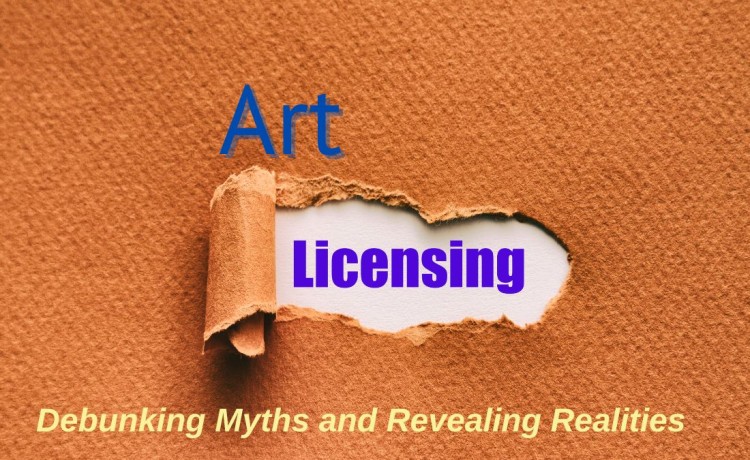In recent years, the art licensing industry has gained significant attention, with many artists viewing it as a potential goldmine for passive income. However, this perception often leads to misconceptions about the nature of the business and what it takes to succeed. This article aims to shed light on the realities of art licensing, dispelling common myths and providing insights into the challenges and opportunities that await aspiring artists in this field.
The Illusion of Easy Money
Perhaps the most pervasive misconception about art licensing is that it’s a quick and effortless path to financial success. The proliferation of online courses promising substantial earnings without the need for advanced artistic skills has only fueled this notion. However, the truth is far more nuanced and demanding.
While art licensing can indeed be lucrative, it requires a substantial investment of time, effort, and skill to reach that point. Success in this industry isn’t about finding a shortcut; it’s about developing a robust portfolio, honing a unique artistic voice, and persistently marketing one’s work. The idea that anyone can enter the field without artistic ability and find immediate success is not only misleading but potentially harmful to those seeking a career in art licensing.
The Importance of a Cohesive Portfolio
Another critical aspect often overlooked is the necessity of a cohesive and targeted portfolio. Many artists, especially those transitioning from in-house or freelance work, are accustomed to being versatile and adapting to various client needs. However, in the licensing world, success often comes from developing a distinctive style and brand voice that sets an artist apart in a saturated market.
Licenseesq are typically looking for artists with a clear aesthetic and consistent quality across their work. This doesn’t mean an artist can’t explore different themes or subjects, but there should be a recognizable thread that ties their portfolio together. Building such a portfolio takes time and introspection, requiring artists to identify their strengths and unique perspectives.
The Long Game of Licensing
Contrary to the “get rich quick” narrative often associated with art licensing, success in this field is typically the result of a long-term strategy. Artists need to approach licensing with patience and persistence, understanding that it may take years to build a substantial income stream.
The process involves not just creating art but also actively seeking out licensing opportunities, building relationships with art directors and licensees, and continuously refining one’s portfolio based on market trends and feedback. It’s a journey of constant learning and adaptation, rather than a one-time effort that yields immediate results.
Balancing Personal Vision with Commercial Appeal
One of the most challenging aspects of art licensing is finding the sweet spot between personal artistic expression and commercial viability. While it’s crucial to create work that resonates with the market, the most successful licensed art often stems from an artist’s unique interests and sensibilities.
Artists need to find ways to infuse popular themes and subjects with their personal style and perspective. This approach not only helps in creating standout work but also ensures that the artist remains passionate and authentic in their creations. The goal is to develop a portfolio that is both commercially appealing and true to the artist’s vision.
The Pros and Cons of Licensing
When compared to other methods of monetizing art, such as producing and selling one’s own products or engaging in artwork buyouts, licensing offers distinct advantages and challenges:
Pros:
- Retention of rights: Artists maintain ownership of their work, allowing for multiple revenue streams from the same piece.
- Lower upfront costs: Unlike self-manufacturing, licensing doesn’t require significant investment in production and inventory.
- Broader market reach: Licensed work can appear on a wide range of products and in various markets.
Cons:
- Delayed gratification: It can take a long time for licensed work to hit the market and generate royalties.
- Less control over final products: Artists may have limited say in how their work is used or reproduced.
- Competitive market: Standing out in a crowded field of talented artists can be challenging.
Navigating the Licensing Landscape
Success in art licensing often comes from a combination of proactive outreach and being discoverable. While some artists are fortunate enough to be approached by companies, many find that actively pitching their work and building relationships in the industry is crucial for sustained success.
This involves:
- Researching potential licensees and understanding their needs
- Tailoring portfolios to specific markets or companies
- Attending trade shows and industry events
- Maintaining an active online presence, including a professional website and social media accounts
- Consistently creating new work and evolving one’s style
The Reality of Art Licensing
Art licensing is not a magical solution for instant artistic success, nor is it a completely passive income stream. It’s a business that requires dedication, strategic thinking, and a willingness to adapt. Artists who succeed in this field typically combine their creative talents with business acumen, market awareness, and persistent self-promotion.
While the challenges are significant, the rewards can be substantial for those who navigate the licensing world successfully. It offers the potential for artists to see their work on a wide range of products, reach global audiences, and build sustainable careers doing what they love.
In conclusion, aspiring artists should approach licensing with realistic expectations and a commitment to continuous improvement. By understanding the realities of the industry, developing a strong portfolio, and persistently seeking opportunities, artists can unlock the true potential of art licensing as a viable and rewarding career path.
- Find out more
- Launch Pad + Accelerator Expressions of Interest
- Selling and Licensing Your Art & Designs Around the World with ArtSHINE.
- Looking for exciting new Art and Designs to license.
We’re here to help you to take action, just like we’ve helped thousands of other entrepreneurs, business owners, and creative professionals all around the globe.
Now is the time to let your passion SHINE.
Now is the time to Make Tomorrow Today!
To your success, Vinh Van Lam and Stuart Horrex Cofounders ArtSHINE.com





